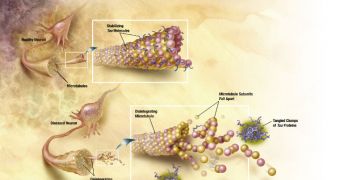Scientists at the University of California in Los Angeles (UCLA) say that they have recently discovered a new potential target for therapies against anxiety disorders such as post-traumatic stress disorder (PTSD), memory-impairment conditions, and also for diseases such as Alzheimer's.
The finding could have a wide array of applications in the field of medicine, the investigators say. They add that the pathway they discovered appears to be completely unexplored in terms of it being used as a medical tool.
Michael Fanselow, an UCLA professor of psychology, was the leader of the research effort. Details of the findings were published in the January 7 issue of the top journal Science.
The expert, who is also a member of the Brain Research Institute at the university, explains some of the basic pathways related to fear that develop in the brain when we go through negative experiences.
For example, the reason why humans and animals start fearing the place and circumstances surrounding a frightening even it because of changes that take place in the brain. Nerve cells on certain neural pathways become more efficient at stimulating and exciting each other.
As such, electrical impulses transmitted from neurons to neuron move faster and more efficiently in these pathways, essentially reminding us of the circumstances and events that frightened us in the past.
The most basic steps in this process can be viewed in neural connections called synapses, areas of contact between nerve cells which are soaked in chemicals called neurotransmitters. The activity pattern these chemicals exhibit can be a good indicator of how signals are passed through.
In addition to the large nerve cells, there are also small, inhibitory neurons in regions of the brain dealing with handling fear, and these cells are connected with each other through channels experts call gap junctions.
These structures are very uncommon in mammals, but they abound in invertebrates. In humans, they can only be found exclusively in certain inhibitory interneurons, the UCLA team says.
“Because of this, no one has looked at the importance of these gap junctions for learning, memory and emotion. We hypothesized that these gap junctions may be very important,” Fanselow explains.
“Because the gap junctions cause the inhibitory neurons to fire together, they may cause these inhibitory neurons to act as a pacemaker for the excitatory neurons, making them fire at the same time so they are better able to make fear memories,” he adds.
In studies conducted on lab rats, researchers determined that using chemicals to block gap junctions renders the brain unable to form fear-related memories in the dorsal hippocampus. This is the area of the brain where such connections are usually formed.
Extrapolating these results in humans could lead to a variety of new treatments for a large number of conditions, the UCLA experts conclude.

 14 DAY TRIAL //
14 DAY TRIAL //